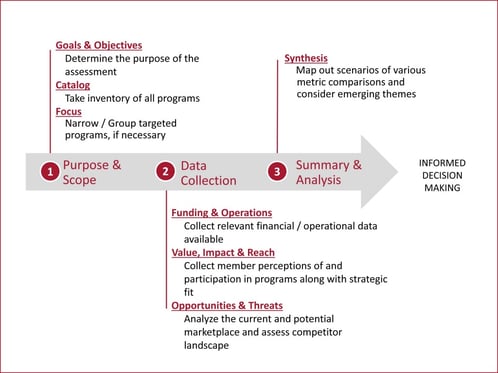Most associations are great at creating new programs in response to member demands. But how many are good at sunsetting low-performers or leaders’ pets? How many take the time to assess products and services and then make strategic decisions based on performance and organizational impacts?
At our first quarter McKinley breakfast, I presented to a group of clients and attempted to answer these questions and more. Associations are unique in the challenges they face in managing a diverse program portfolio. Unlike the for-profit world, your primary goal is not to increase shareholder value; rather it’s to meet the ever-growing needs of members while advancing the mission. So it’s no surprise that many associations lack the flexibility of for-profit organizations to invest resources in analytics at the program level. And without objective information that comes from such analytics, strategic decisions on offerings are made on what is available: namely intuition, past experience, etc. Another challenge is momentum: associations are often reluctant to stop projects underway.
These factors, collectively, can pose real difficulties in identifying and discussing the true value and the true cost of a program. The bottom line: the ability to objectively see how your offerings impact your organization will allow you to make informed decisions on how best to allocate resources, where to accelerate and where to slow down, ultimately enhancing your ability to meet strategic goals.
And we have reason to believe that associations are gearing up to expand. McKinley recently published its annual Economic Impact on Associations study and a key finding indicated a shift toward program expansion. “More than six-in-ten respondents (61%) reported that their associations are currently expanding or planning to expand their programs and services this year.” As the association community continues to recover from the economic recession, it is likely that core membership will expand and the demand on internal infrastructure and operational capacity will increase. Now more than ever, it is imperative for associations to evaluate and prioritize existing products and services. There are often many more ways in which to launch new projects than there are to retire them.
Conducting a portfolio assessment is one way to work through these challenges and provide actionable data to inform strategic decisions. A full portfolio assessment enables you to understand:
- Your offerings in the context of member usage and value
- The current resource allocation
- The true cost your association bears to provide that initiative
To give you an overview of a portfolio assessment see the diagram below which illustrates the three main components of a program assessment: Purpose & Scope, Data Collection, and Summary & Analysis.
Program assessment are about understanding your existing projects and identifying those that should be maintained as they are, those that need some tweaking, and those that can be put on the watch list. As associations seek to increase member value, taking the time to evaluate the current offerings in place will go a long way toward enabling successful delivery on that value.
Tag(s):
McKinley Advisors
McKinley Advisors is an award-winning association consulting firm dedicated to accelerating associations’ positive impact on the world. McKinley works in partnership with association executives and volunteer leaders to identify and address their most significant challenges and opportunities. McKinley provides services...
Business Models
5 min read
| November 12, 2025
Is Your Association Ready for a Portfolio Analysis?
Read More
Market Research
8 min read
| October 24, 2025
What Your Association Should Expect from Research Partners
Read More
featured
10 min read
| August 20, 2025







